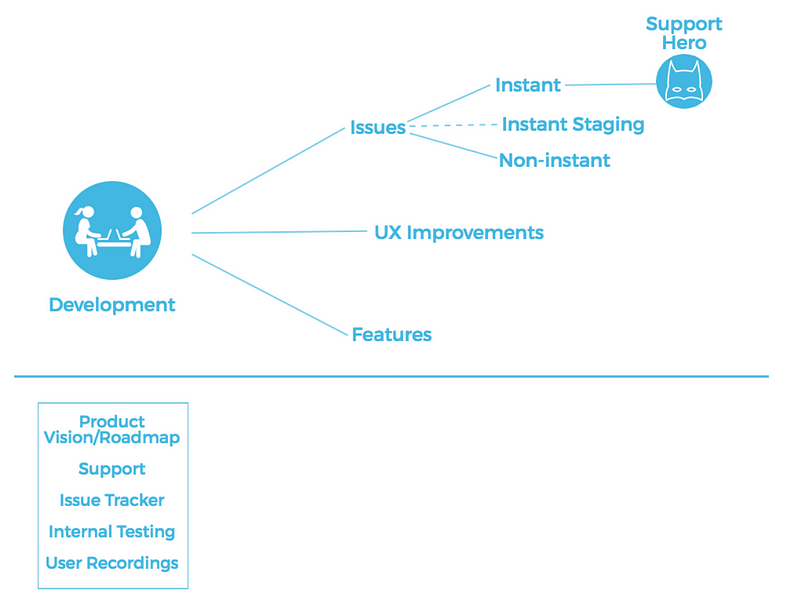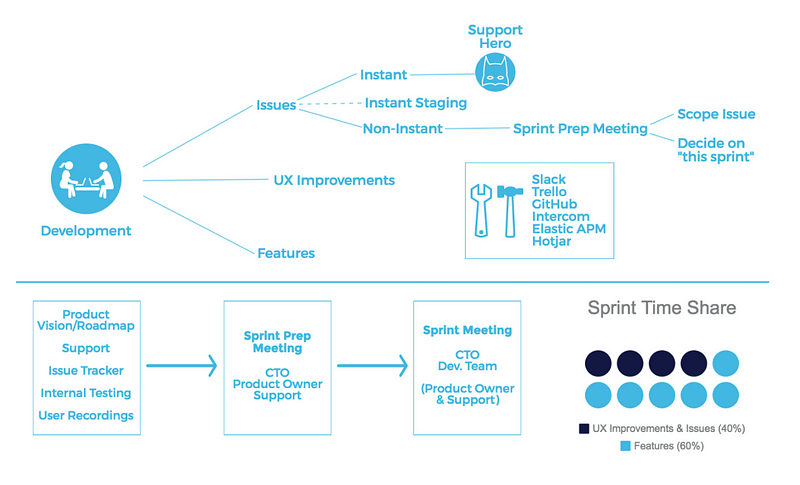Wie man die Entwicklung in einem schlanken Software-Startup organisiert
Innen Salesflare
Die Gründung eines Technologieunternehmens kann ein chaotischer, stressiger und lohnender Prozess sein.
But one of the things that can really help early on is to have structures in place that empower your team to work effectively and efficiently — especially on the development side. The last thing your company needs is chaos around building your product. 😱
Wie fangen Sie also an? Und sollen Sie outsourcen oder intern einstellen?
Below is a quick guide to building and structuring your SaaS development team — and if you do decide to outsource, you can use this guide as a framework as well. 🤩
Categorizing development at your company
One of the things that can help with development structure is to break down the different types of development tasks at the company into categories, so you can have a better idea of prioritization, delegation and organization within the team. 🤝
Nachstehend finden Sie die drei Entwicklungskategorien, die wir bei Salesflare haben:
Ausgaben sind Dinge, die im Produkt kaputt sind und behoben werden müssen.
But what has priority? And how do you organize them? That’s why we’ve broken issues down into three additional categories: instant issues, instant staging and non-instant issues.
Instant issues are the ones that — you guessed it — need to be addressed immediately. These can be things that are really broken, things that the users notice, things in the app that need to be fixed, etc. 🚨

Instant staging is not as “instant” as instant issues, but these are things that need to be fixed before releasing the newest software version into the production environment. These are mostly issues that we notice on our staging environment through internal testing.
Nicht-unmittelbare Probleme haben eine geringere Priorität und werden in der Sprint-Vorbereitungssitzung besprochen (mehr dazu später).
UX-Verbesserungen haben eine höhere Priorität als nicht dringende Probleme und umfassen alles in der Entwicklung, was sich auf die Erfahrung und die Benutzerfreundlichkeit des Produkts bezieht. Im Wesentlichen sind dies Dinge, die das Erlebnis für die Kunden verbessern.
Eigenschaften sind neue Funktionalitäten, die wir dem Produkt hinzufügen wollen, wie z.B. Massenaktionen, erweiterte Filterung, usw. Diese sind die niedrigste Priorität der geplanten Aufgaben während eines Sprints.
Die Aufschlüsselung der Entwicklungsarten kann Ihnen helfen, Ihr Team besser zu organisieren, aber wie entscheiden Sie, wer sich um was kümmert?

Support Hero is here to save the day!
As a SaaS company ourselves, we understand the importance of addressing issues promptly to give customers the best experience possible. However, that doesn’t mean that we should have the entire team spending their days jumping on issues — we’d never get any other work done! 👨💻👩💻
That’s why we use a system that both removes distractions and increases productivity within the development team. We call it the Support Hero.

The Support Hero is one person on the development team, rotated daily, that focuses on instant issues that need to be addressed (and answers more in-depth and technical questions users have), so that the team can stay focused on their tasks. 💪
Any issues that can’t be fixed in that exact moment by the Support Hero are logged in GitHub, the software we use for code and issue management, and is then addressed as soon as possible.
The beauty of having a Support Hero is that even with a small team, you can offer high-quality support to your customers — any in-depth technical issues can be fixed on the spot, avoiding the frustrating process of having to hand off issues to the “right” person.
Das Beste daran: having a Support Hero brings your developers closer to your customers. 💛
It’s all about structure
Now that we’ve touched on the types of development and how to delegate issues, let’s discuss how to organize your structure. All of the different components below come together to inform how the team moves forward.
Eine Produktvision und ein Fahrplan can help you know where you want to bring the product, so you can then have features in mind that will get you there — this ideally overlaps with what you pick up from your support. 👓
Unterstützung ist alles über Kundenfeedback. Dazu gehören Funktionsanfragen, Probleme und UX-Verbesserungen, die sich an der oben genannten Produktvision und Roadmap orientieren. Halten Sie diese fest und bringen Sie sie in die Vorbereitungssitzung für den Sprint ein.
Ein Fehlerverfolgungssystem reports errors both on the back-end and the front-end. It also allows you to see what issues appear even without people telling you. One suggestion is Elastic APM — but there are many options out there.
Interne Tests allows your whole team to test new features before they go live. We test actively before releasing updates from staging to production. And since we use Salesflare internally, we can therefore detect possible issues and improvements in the product ourselves as well. It’s always good to have your team use your product whenever possible to get first-hand exposure to any issues that can arise and to have a deep understanding of your own product.
Hotjar Aufzeichnungssitzungen können Ihrem Team dabei helfen, zu sehen, wie die Leute mit dem Produkt interagieren und wo Dinge schief laufen (oder richtig). Nutzeraufzeichnungen sind zwar nicht täglich erforderlich, können Ihnen aber zusätzliche Einblicke in die Nutzung Ihres Produkts geben, da Sie sehen können, was die Nutzer tun, ohne dass sie es Ihnen erklären müssen.

Time to sprint!
Structure your development team’s work into sprints — an agile methodology. As a general guideline, two-week-long sprints are most common for IT and software product development. 🏃
However, it’s recommended to prepare ahead of your sprint meetings — otherwise things can get a bit chaotic and off-topic.
This can be addressed by having sprint preparation meetings. The CTO, product owner, and product manager (read more about the difference between product owner vs product manager) attend this meeting, and use this time to look at instant issues that are remaining, UX improvements, non-instant issues, and features. This helps set the agenda and priorities for the upcoming sprint without needing to take time out of the sprint meeting itself. ✅
Then, of course, it’s time to have your sprint meeting! The sprint meeting zooms in technically on what was discussed during the sprint preparation meeting, so that the development team knows exactly how they will go about things. It also gives a platform to review instant issues together as a team. This meeting should include the CTO and development team. The product owner and support team can also join, but are less needed at this stage.
At the start of this meeting, it’s a good idea to reflect on the previous sprint — what went well, what went wrong, etc.

What’s in your toolkit?
The tools you use within your company can set your development team up for success. We’ve already touched on Hotjar and Elastic APM, but some other tools to consider for more streamlined communication and task management include:
Slack — für interne Diskussionen, Aktualisierungen/Benachrichtigungen, Dateiaustausch und gelegentliche lustige Gifs
Trello — für Aufgabe/Projektverwaltung und -verfolgung wer was in einem bestimmten Sprint macht
GitHub — wo wir Probleme, Funktionsanfragen usw. verfolgen.
Intercom — für die Kommunikation mit den Kunden
A great aspect of using these tools is that they can interact with one another. For example, we get updates from Trello and Github in Slack. And in Trello we use a GitHub power-up that integrates GitHub info into Trello. 🌐
Außerdem können wir GitHub mit Intercom-Unterhaltungen verknüpfen, so dass wir immer den Kontext zur Hand haben; und wenn wir Funktionen ausliefern oder Probleme beheben, können wir ohne Fehler darüber kommunizieren.

Regardless of how you decide to structure development at your company, it’s always important to make sure that your team — no matter how big or small — can work within the processes you decide to utilize. 🚀
Don’t be afraid to change things if they aren’t working! The key is to find what works for you and your company and go with that.
Wir hoffen, dass diese Kurzanleitung Ihnen ein paar Anregungen für den Aufbau und die Struktur Ihres Entwicklungsteams gegeben hat!
Have more great ideas? Tell us in the comments! ✨
Hat Ihnen dieser Beitrag gefallen? Sehen Sie sich den Rest unserer Innen Salesflare Serie.
Weitere aktuelle Informationen über Start-ups, Wachstumsmarketing und Vertrieb
- 22+ Beste Vertriebs-Podcasts, die Sie sich 2024 ansehen sollten - 21. Dezember 2023
- Cold-Calling-Skripte für echte Menschen - 21. September 2023
- Die 25+ besten Verkaufstools, die Ihr Team erfolgreich machen - 10. August 2023
